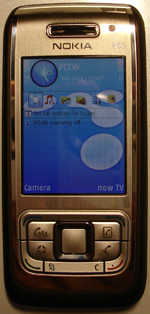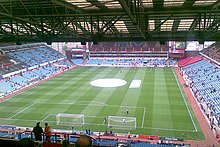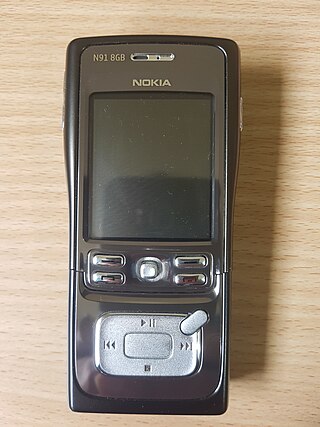
The Nokia N91 is a mobile phone produced by Nokia as part of their Nseries line of portable devices. It was announced on April 27, 2005 along with N70 and N90 as the first three Nseries devices. The N91 ran on Symbian-based S60 3rd Edition. It was the first ever phone encompassing a 4 GB internal hard drive, allowing storage for 3,000 songs. The N91 is highly focused on music. with dedicated music keys on the front which slide down to reveal the keypad. It also featured the industry-standard 3.5 mm headphone jack, and was anticipated as a major challenger to Apple, whose iPod dominated the industry. The design of the N91 is based on stainless steel with a matte finish.

A mobile phone feature is a capability, service, or application that a mobile phone offers to its users. Mobile phones are often referred to as feature phones, and offer basic telephony. Handsets with more advanced computing ability through the use of native code try to differentiate their own products by implementing additional functions to make them more attractive to consumers. This has led to great innovation in mobile phone development over the past 20 years.
Push email is an email system that provides an always-on capability, in which when new email arrives at the mail delivery agent (MDA), it is immediately, actively transferred (pushed) by the MDA to the mail user agent (MUA), also called the email client, so that the end-user can see incoming email immediately. This is in contrast with systems that check for new incoming mail every so often, on a schedule. Email clients include smartphones and, less strictly, IMAP personal computer mail applications.
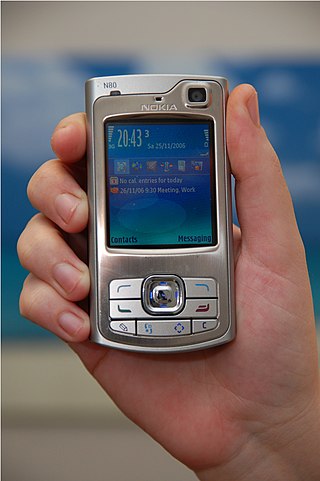
The Nokia N80 is a 3G mobile phone from Nokia announced on November 2, 2005, part of the multimedia Nseries line. It runs on Symbian OS v9.1 and the S60 3rd Edition interface. It was first released in June 2006.

The Nokia N95 is a mobile phone produced by Nokia as part of their Nseries line of portable devices. Announced in September 2006, it was released to the market in March 2007. The N95 ran S60 3rd Edition, on Symbian OS v9.2. It has a two-way sliding mechanism, which can be used to access either media playback buttons or a numeric keypad. It was first released in silver and later on in black, with limited edition quantities in gold and purple. The launch price of the N95 was around €550.

The Nokia N73 is a mobile phone announced by Nokia on 2006 as part of the Nseries and started shipping on 15 July. The N73 succeeded the N70 and packed in numerous multimedia features. It features a 3.2 megapixel autofocus camera, a front camera, a then-large 2.4-inch display, and stereo speakers, all in a relatively slim and pocketable size and form. It runs on Symbian v9.1. An improved, music-focused version called N73 Music Edition was released in 2007.
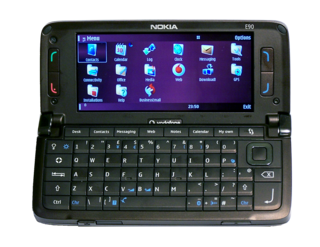
Nokia E90 Communicator is a high-end 3G mobile phone from Nokia, the fifth generation and final Communicator, also part of the Eseries. It was announced on 11 February 2007 at the 3GSM show in Barcelona. It succeeded the Nokia 9500 Communicator as the company's flagship business-oriented device. Its clamshell form and design are reminiscent of older palmtop computers.

The Nokia 6110 Navigator is a mobile phone made by Nokia, announced on 12 February 2007. It has been available since June 2007. It runs on Symbian OS v9.2 with a S60 3rd Edition FP1 user interface. It is not to be confused with the 1997/98 Nokia 6110. The Nokia 6110 Navigator includes pre-loaded navigation maps.

The Nokia N96 is a discontinued high-end mobile phone announced by Nokia on 11 February 2008 at the Mobile World Congress in Barcelona as part of the Nseries line. The N96 runs Symbian OS v9.3. It is compatible with the N-Gage 2.0 gaming platform and has a DVB-H TV tuner and AV output.

The Nokia E71 is a mobile phone introduced on 8 May 2008 from the Eseries range with a QWERTY keyboard targeting business users worldwide. It runs on Symbian OS v9.2, with a Series 60 3rd Edition, second generation Feature Pack 1. The Nokia E71 succeeded the Nokia E61/61i models, building on the base design and form factor but enhancing on the feature set.
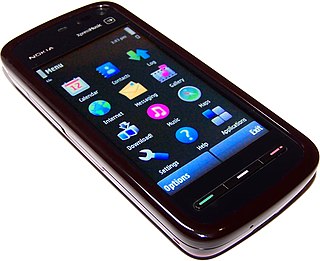
Nokia 5800 XpressMusic is a smartphone part of the XpressMusic line, announced by Nokia on 2 October 2008 in London and started shipping in November of that year. Code-named "Tube", it was the first touchscreen-equipped S60 device by Nokia – essentially it was the first device to run Symbian^1, also known as S60 5th Edition, the touch-specific S60-based platform created by the Symbian Foundation. The touchscreen features tactile feedback.

The Nokia N97 is a high-end smartphone introduced on 2 December 2008 by telecommunications manufacturer Nokia as part of its Nseries and released in June 2009 as the successor to the Nokia N96 phone. The N97 was Nokia's second S60-based touchscreen phone, after the Nokia 5800 XpressMusic. The device featured slide-out QWERTY keyboard, and ran on the Symbian v9.4 operating system. Its design took cues from the Nokia N79. A smaller and lower-cost variant, the Nokia N97 mini, was later released.

The Nokia E63 is a mobile phone announced on 12 November 2008 and released later that year. It is based on Symbian's S60 software platform and is considered a budget business smartphone positioned below the Nokia E71, featuring a plastic body instead of metal. Many of the specifications are identical to the E71 except for the lack of GPS and infrared, a lesser RAM, lack of HSDPA and lower-resolution camera with a fixed-focus lens. The E63 does come with a flashlight function using the camera flash, which is not present in the E71. It also has a more standardized 3.5 mm audio jack whereas the E71 uses a 2.52 mm jack as used on older Nokia phones. The E63 retailed for about 199 euros before taxes. The device was succeeded by the Nokia E5, but remain in production until its discontinuation in late 2011 in favour of Nokia's Lumia lineup.

The Nokia E52 and Nokia E55 are mobile phones from Nokia's business-oriented Eseries range. They run Symbian OS v9.3. The E55 was announced on 16 February 2009, whilst the E52 was announced later on 6 May 2009. They are both physically and functionally identical, except that the E55 has a 'half-QWERTY' keyboard, similar to the SureType keyboard on BlackBerry Pearl, whereas the E52 revision has a traditional T9 keypad.
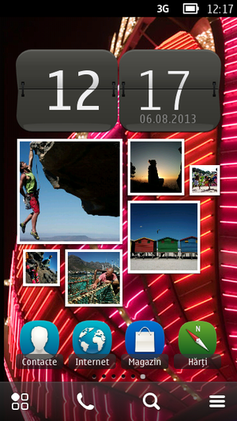
Symbian is a discontinued mobile operating system (OS) and computing platform designed for smartphones. It was originally developed as a proprietary software OS for personal digital assistants in 1998 by the Symbian Ltd. consortium. Symbian OS is a descendant of Psion's EPOC, and was released exclusively on ARM processors, although an unreleased x86 port existed. Symbian was used by many major mobile phone brands, like Samsung, Motorola, Sony Ericsson, and above all by Nokia. It was also prevalent in Japan by brands including Fujitsu, Sharp and Mitsubishi. As a pioneer that established the smartphone industry, it was the most popular smartphone OS on a worldwide average until the end of 2010, at a time when smartphones were in limited use, when it was overtaken by iOS and Android. It was notably less popular in North America.

The Nokia 5230 is a smartphone manufactured by Nokia, running Symbian OS v9.4, S60 5th Edition. It was released in November 2009 after being announced in August of the same year.
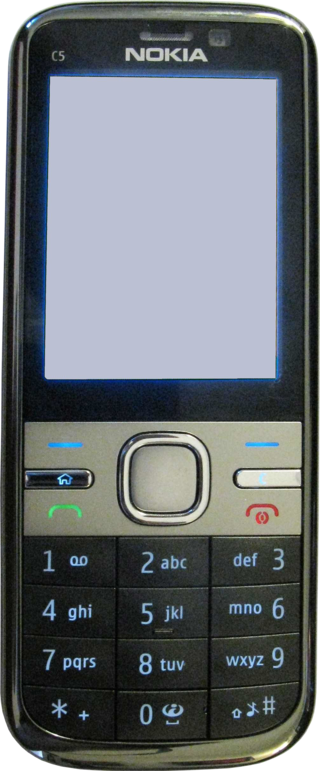
The Nokia C5-00 is the first in the new Cseries of Nokia phones, announced March 2010. The C5-00 is a mobile phone with messaging and social networking features, including, for example, Facebook and Flickr applications. The C5-00 allows multitasking and has a 2.2-inch (56 mm) display and a 5.0-megapixel camera. It also includes GPS and a free navigation courtesy of Ovi Maps. It runs on Symbian OS with S60 3rd Edition Feature Pack 2.
Nokia's strategic nomenclature can be traced back in 2005 when the Nseries line was launched, offering devices with flagship specifications and premium hardware at various price points. These devices were considered the "bread and butter" of the company and were often positioned to showcase their latest technologies. Thanks to the newfound consumer and enterprise interest in smartphones at the time, the company introduced four additional collections to diversify their product portfolio and meet demands in most market segments. These new phone series were named Eseries, targeting small business and enterprise customers; Xseries, providing consumer-grade multimedia-focused devices; Cseries, which Nokia used to target both the low-end and mid-range market segments; and Tseries, for devices exclusive to the Chinese market.
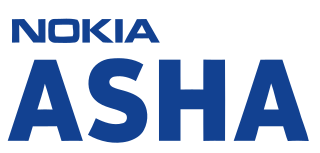
The Nokia Asha 303 is a QWERTY messenger smartphone powered by Nokia's Series 40 operating system. It was announced at Nokia World 2011 in London along with three others Asha phones - the Nokia Asha 200, 201 and 300. The 303 is considered to be the flagship of the Asha family. Its main features are the QWERTY keyboard and capacitive touchscreen, the pentaband 3G radio, SIP VoIP over 3G and Wi-Fi and the ability to play Angry Birds which were all never seen before on a Series 40 phone. Nokia Asha 303 is available in a number of languages depending on which territory it is marketed for. Models sold in South Asia support at least eight languages: English, Hindi, Gujarati, Marathi, Tamil, Kannada, Telugu and Malayalam.
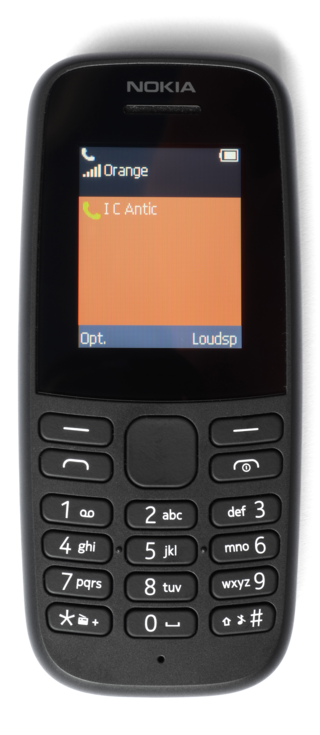
Nokia Series 30+ is a software platform and application user interface used for Nokia-branded mobile devices. The platform was introduced by Nokia in September 2013, first appearing on the Nokia 108, and has been the main Nokia feature phone operating system after the end of the Series 30 and Series 40 platforms in 2014. Despite the similar name and user interface, S30+ is technically completely different and unrelated to S30.
